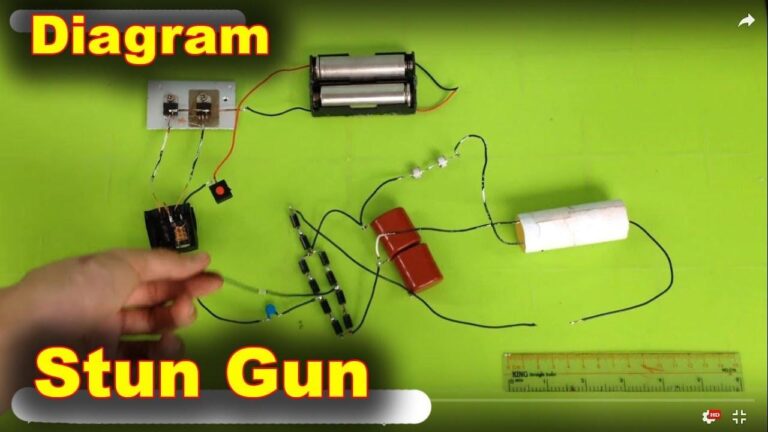Table of Contents
- Identifying Common Wiring Issues in Stun Guns
- Essential Tools and Safety Precautions for Repair
- Step-by-Step Process to Diagnose and Fix Wiring Faults
- Testing and Maintaining Your Stun Gun for Long-Term Reliability
- Closing Remarks
Identifying Common Wiring Issues in Stun Guns
When troubleshooting your stun gun’s wiring, certain patterns tend to emerge, pointing to common faults that affect functionality. One of the primary culprits is corroded connections, which often occur due to moisture exposure or improper storage. Corrosion can interrupt electrical flow, causing intermittent or complete failure. Another frequent issue is loose wiring, typically caused by vibrations from repeated use or accidental drops. This can result in inconsistent power delivery to the stun gun’s electrodes. Worn insulation, which exposes internal wires, can also cause short circuits or unintentional grounding, severely compromising the device’s operation.
Other signs to watch out for include frayed cables, often from over-flexing or poor handling, and broken solder joints inside the circuitry which might break electrical continuity. It’s also important to inspect the wiring color codes, as mismatches or repairs using incorrect wiring may lead to malfunctioning circuits. Here are some key symptoms that hint at wiring problems:
- Device fails to deliver a consistent shock.
- Unexpected power fluctuations or dimming indicator lights.
- Audible buzzing or unusual sounds indicating electrical shorts.
- Visible damage or melting marks around wiring areas.
Essential Tools and Safety Precautions for Repair
Before embarking on the delicate task of repairing a stun gun’s wiring, having the right tools at your disposal is crucial to ensure precision and safety. Equip yourself with a quality multimeter for accurate voltage and continuity testing, fine-tipped soldering irons designed for miniature electronics, and heat shrink tubing to insulate repaired wires effectively. Additionally, use wire strippers with adjustable settings to avoid damaging thin wires, along with precision screwdrivers tailored for the compact screws typical of stun guns. Ensure your workspace is well-lit and organized, minimizing the risk of errors during intricate wiring work.
Safety should never be an afterthought when handling high-voltage devices like stun guns. Always disconnect the power source and remove the battery before opening the casing. Use insulated gloves to protect yourself from unexpected electrical discharge, and work on a non-conductive surface to reduce shock hazards. It’s also advisable to wear protective eyewear in case of accidental short circuits or sparks. Never rush the process; methodically double-check your connections, and if unsure at any point, consult a professional technician. Adhering to these precautions ensures both your safety and the longevity of the stun gun after repair.
Step-by-Step Process to Diagnose and Fix Wiring Faults
Begin by carefully inspecting the stun gun’s wiring harness for any visible signs of damage such as frayed insulation, exposed wires, or corrosion. Use a multimeter to test continuity across wires, ensuring each connection is intact and functioning correctly. Pay special attention to solder joints and connectors, as these are common failure points. If any wire shows no continuity or resistance values outside the manufacturer’s specifications, mark it for repair or replacement. Maintain a clean, dry working environment to prevent further damage during this diagnostic phase.
Once faults are identified, proceed by securely stripping back insulation from damaged sections and replacing them with properly gauged wire. For optimal results, use heat-shrink tubing instead of electrical tape to insulate the new connections, ensuring durability and resistance to wear. Re-solder loose joints and reinforce all connections with cable ties to minimize future movement or strain. Finally, reassemble the components carefully and re-test the stun gun in a controlled setting to confirm that the wiring repairs have resolved the issue safely and effectively.
- Tools needed: Multimeter, wire strippers, soldering iron, heat-shrink tubing, cable ties
- Safety tip: Always disconnect the stun gun from any power source before starting repair work
- Testing method: Use continuity and resistance settings on the multimeter for thorough diagnosis
Testing and Maintaining Your Stun Gun for Long-Term Reliability
Ensuring your stun gun remains dependable over time starts with regular and thorough testing. Begin by inspecting the wiring connections for any signs of wear, corrosion, or loose fittings, as these issues frequently cause malfunctions. Use a multimeter to measure continuity across the wires, which helps pinpoint breaks or shorts within the circuit. Never attempt to operate the stun gun if any wiring defects are detected; focus instead on securing professional repairs or carefully following trusted DIY guidelines to replace faulty wiring components.
Maintaining peak performance also involves adopting a routine care regimen that includes:
- Cleaning contact points with a dry cloth to prevent residue buildup.
- Storing the stun gun in a dry, cool environment to avoid moisture-related damage.
- Regularly checking battery health and replacing batteries to ensure consistent voltage delivery.
By incorporating these practices, you significantly extend the life of your stun gun and uphold its operational integrity, ensuring you’re never caught unprepared in critical situations.
Closing Remarks
Fixing faulty stun gun wiring can seem like a daunting task, but with the right tools and careful attention to detail, it’s entirely manageable. Remember, safety should always be your top priority when handling electrical components, especially in devices designed for self-defense. By following the professional tips outlined in this guide, you can restore your stun gun to reliable working order and avoid costly replacements. If you ever feel uncertain, don’t hesitate to seek help from a qualified technician. Taking control of your device’s maintenance not only extends its lifespan but also ensures it’s ready when you need it most. Stay safe and stay empowered!Check Our Other Blogs
- StunGun – Your Trusted Source for Stun Guns, Laws, and Self-Defense Tips
- PepperSprayLaws – Your Trusted Resource for Pepper Spray Information
- StunGunLaws – Your Trusted Guide to Stun Gun Legality and Safety





